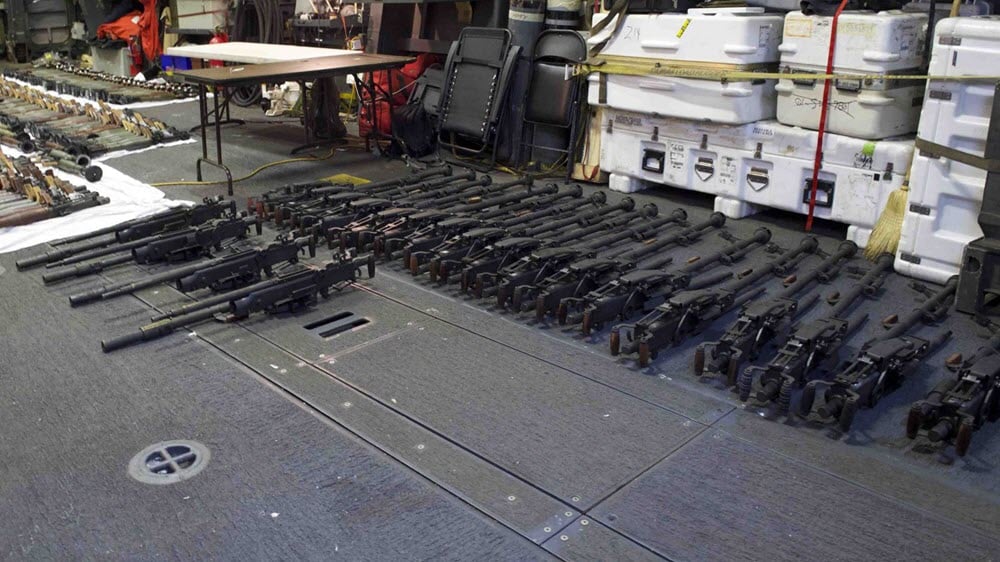Facebook
Twitter
LinkedIn
Pinterest
Reddit
Email
Print
 Seized weapons aboard USS Gravely (DDG 107), intercepted from a dhow suspected of smuggling Iranian arms to Yemen’s Houthis. (Courtesy: commons.wikimedia.org)- March 31, 2016
Seized weapons aboard USS Gravely (DDG 107), intercepted from a dhow suspected of smuggling Iranian arms to Yemen’s Houthis. (Courtesy: commons.wikimedia.org)- March 31, 2016
Three-minute read
The recent escalation of Houthi attacks on commercial vessels in the Red Sea has once again spotlighted the Iranian regime’s destabilizing role in the region. Backed by Tehran with advanced weaponry, the Houthis are emerging as a central pillar in Iran’s long-standing strategy of asymmetric warfare—using non-state actors to sow chaos, leverage geopolitical negotiations, and deflect attention from domestic unrest.
Khamenei’s Public Endorsement
On July 14, 2025, the Persian-language X account affiliated with Iran regime’s Supreme Leader Ali Khamenei praised the Houthi attacks on commercial shipping. In the message, Khamenei called the actions of the “people of Yemen and the Ansar Allah government… truly admirable” and hoped such resistance would continue.
This endorsement was not only a clear affirmation of Iran’s backing of the Houthis but also an effort to frame the militia as the legitimate representative of the Yemeni people—an assertion widely rejected by the international community, which recognizes Yemen’s internationally backed government and views the Houthis as an Iranian regime proxy force.
“#Iran‘s supreme leader Ali Khamenei defiantly denied that the Houthis were a proxy following last weekend’s US air strikes. But intelligence from @Mojahedineng /NCRI inside #Iran shows this is far from true.” @marcogiann writes in @Daily_Expresshttps://t.co/gTMIoDRSbr
— NCRI-FAC (@iran_policy) March 23, 2025
A Threat to Global Trade
On July 12, 2025, Fox 40 reported that Houthi forces had sunk a Liberian-flagged cargo ship in the Red Sea, killing at least four crew members and rescuing only six out of a crew of 25. This was part of a broader wave of attacks within a 48-hour period targeting two commercial vessels. Armed with Iranian-supplied ballistic missiles, drones, and rocket-propelled grenades, the Houthis have turned the Bab el-Mandeb Strait—one of the world’s most critical maritime chokepoints—into a volatile zone.
According to Hal Kempfer, CEO of GRIP (Global Risk Intelligence & Planning Inc.), “the temporary ceasefire between Houthis and international forces, including the United States, has always been fragile.” He highlighted that the current lack of international naval presence in the Red Sea, due to heightened tensions near the Strait of Hormuz, has emboldened Iran regime’s proxies to act more freely.
Amb. Mohammed Al-Hadhrami outlines a new strategy to address the Houthi threat, emphasizing their reliance on #Iran‘s regime and the IRGC. He urges the U.S. to designate the #Houthis as a foreign terrorist organization, a move similar to those against Hezbollah and the IRGC. pic.twitter.com/k4FgxNyklD
— NCRI-FAC (@iran_policy) December 25, 2024
Iran Regime’s Proxy Doctrine
Following the 12-day war and U.S. airstrikes on Iranian nuclear sites, Iranian-aligned militias resumed attacks across the region. The regime’s broader strategic playbook—built around manufacturing crises to serve political and security objectives—relies heavily on the empowerment of armed non-state actors.
Kempfer emphasized the unique advantage the Houthis hold: their geographic position in Yemen, the weakened capacity of regional governments to engage them directly, and Iran’s continued material support. They may now be the strongest of Iran’s proxies, he said, especially after Hezbollah’s capabilities in Lebanon became extremely weakened.
Mizan also reported, “@X deactivated the official account of Ansar Allah (#Houthis) website without any legal justification. The management of Ansar Allah’s media outlet considered deactivating its official account on the X platform a violation of all human rights laws and… pic.twitter.com/a7fFrUWmYX
— NCRI-FAC (@iran_policy) February 18, 2024
Regional Instability and Global Costs
The consequences of the Houthi attacks are not confined to Yemen or the Red Sea. The assaults have raised insurance and transportation costs, disrupted global supply chains, and triggered international condemnation. The UN Secretary-General has called for de-escalation and a peaceful resolution to the Yemeni conflict. But as long as Iran’s regime continues to arm and politically support the Houthis, prospects for peace remain bleak.
Inside Iran, the regime uses these external crises to justify domestic repression and distract from internal dissent and economic hardship. This manufactured external threat serves as a smokescreen for a ruling system under immense pressure from within.
#Iran Regime Admits Ordering #Houthi Attack on #Saudi Oil Tanker
A commander in the Iranian Regime’s Revolutionary Guards Corps (IRGC) has admitted that the recent attack of two Saudi oil tankers in Bab al-Mandeb Strait by the Yemeni Houthis was…https://t.co/9rpDJgTQ8P pic.twitter.com/9PjP0Ck8Iu
— NCRI-FAC (@iran_policy) August 8, 2018
Ending the Cycle of Proxy Warfare
By sustaining conflicts on multiple fronts through its proxies, Tehran seeks to fortify its negotiating position abroad while tightening its grip at home.
Cutting off Iran regime’s supply routes to its proxies is vital. But ultimately, without addressing the source of this regional aggression—the Tehran regime itself—the Middle East will remain vulnerable to further instability.
Any sustainable solution requires empowering the Iranian people and organized resistance to challenge the current regime’s grip on power. Until then, groups like the Houthis will continue to serve as instruments of Tehran’s perpetual war machine, destabilizing the region and threatening global peace and commerce.